Marketing Management: Strategic Analysis of IKEA and Apple Inc. Report
VerifiedAdded on 2023/05/30
|9
|1907
|157
Report
AI Summary
This report provides a comprehensive analysis of marketing strategies, focusing on the application of SWOT analysis. It begins with an executive summary, followed by an introduction to marketing strategy and the SWOT framework. The report defines internal and external factors, illustrating how IKEA manages business threats and leverages SWOT for growth. A detailed SWOT analysis of Apple Inc. is also presented, covering its strengths, weaknesses, opportunities, and threats. The report concludes by emphasizing the importance of evaluating business operations using the SWOT framework for effective strategic planning and achieving a competitive edge. The report utilizes examples from IKEA and Apple Inc. to demonstrate real-world applications of the concepts discussed.
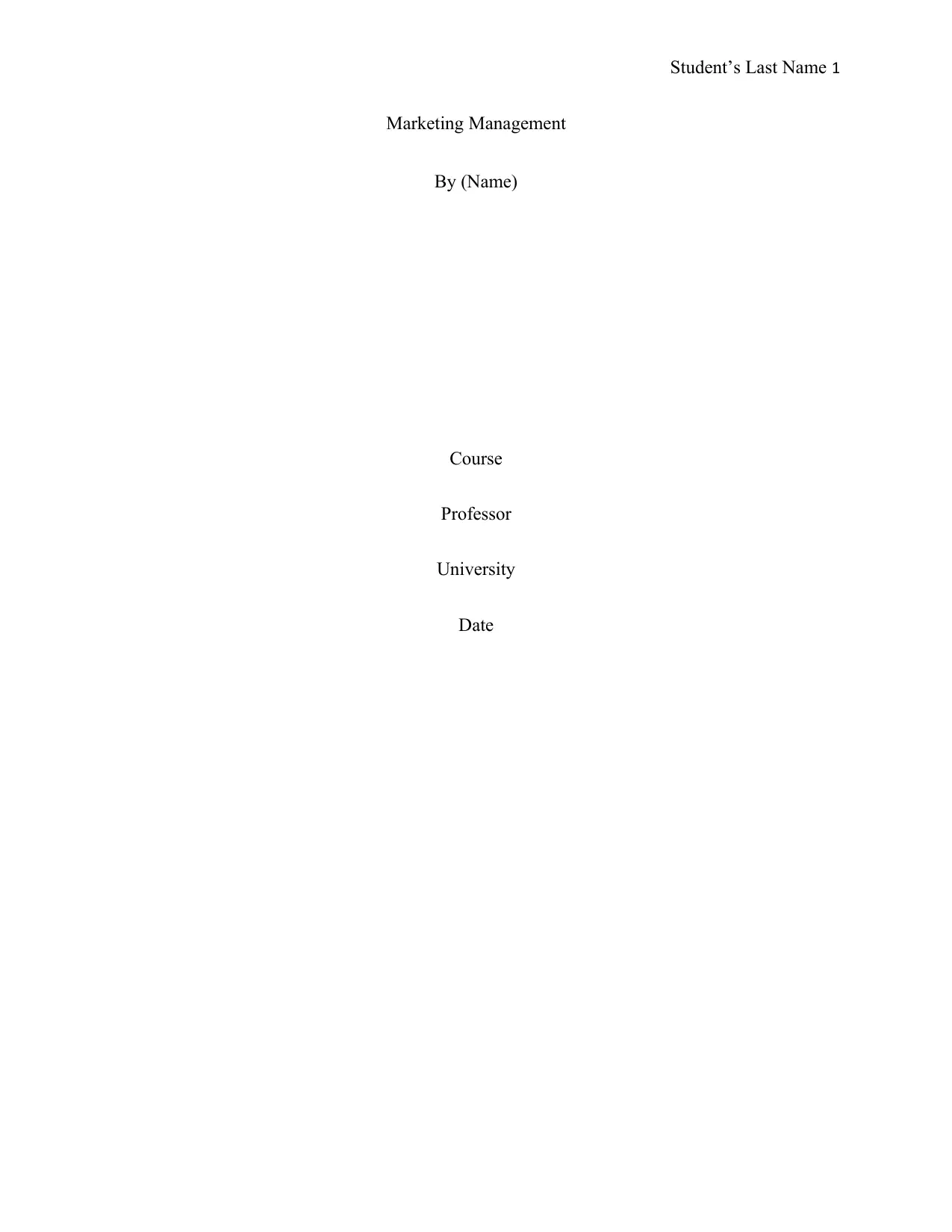
Student’s Last Name 1
Marketing Management
By (Name)
Course
Professor
University
Date
Marketing Management
By (Name)
Course
Professor
University
Date
Paraphrase This Document
Need a fresh take? Get an instant paraphrase of this document with our AI Paraphraser
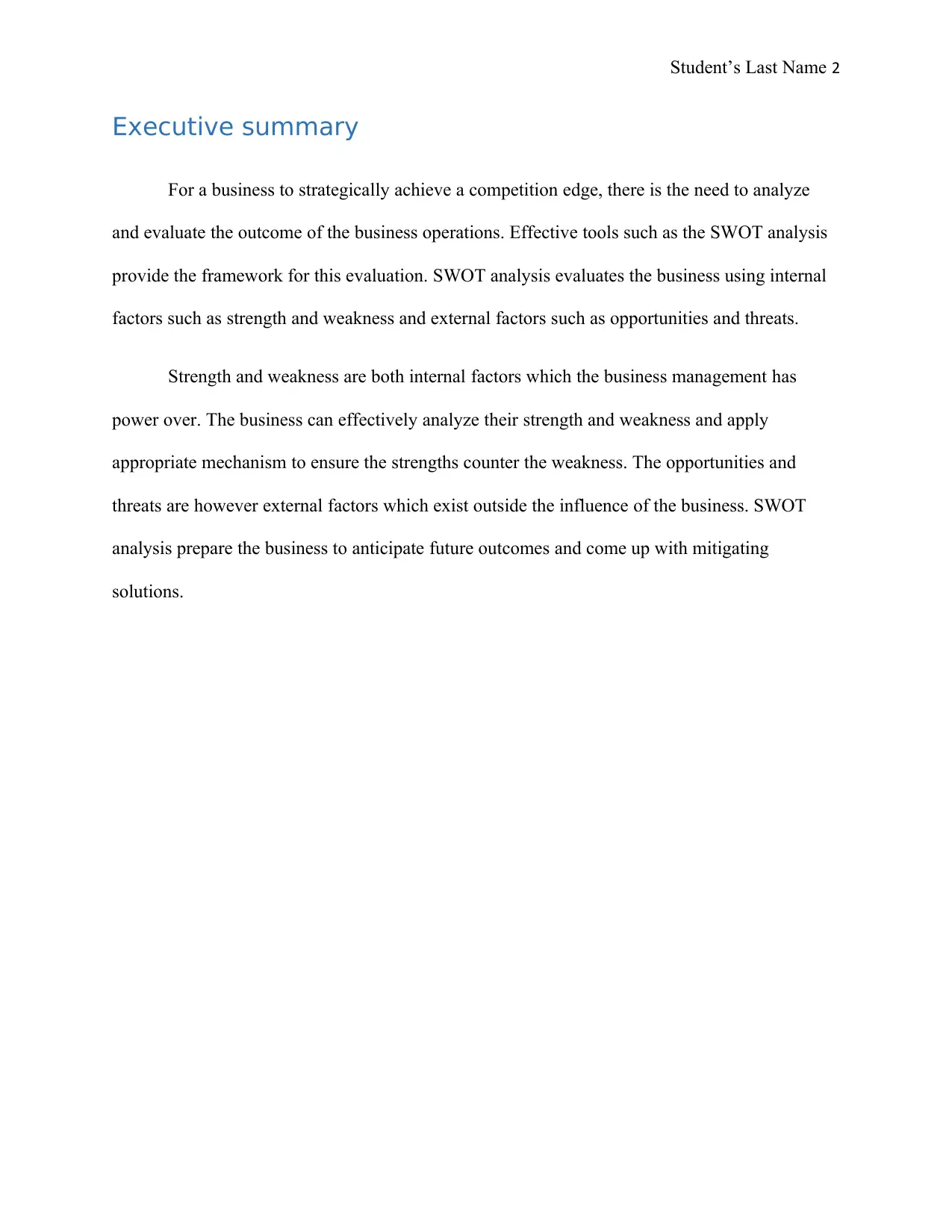
Student’s Last Name 2
Executive summary
For a business to strategically achieve a competition edge, there is the need to analyze
and evaluate the outcome of the business operations. Effective tools such as the SWOT analysis
provide the framework for this evaluation. SWOT analysis evaluates the business using internal
factors such as strength and weakness and external factors such as opportunities and threats.
Strength and weakness are both internal factors which the business management has
power over. The business can effectively analyze their strength and weakness and apply
appropriate mechanism to ensure the strengths counter the weakness. The opportunities and
threats are however external factors which exist outside the influence of the business. SWOT
analysis prepare the business to anticipate future outcomes and come up with mitigating
solutions.
Executive summary
For a business to strategically achieve a competition edge, there is the need to analyze
and evaluate the outcome of the business operations. Effective tools such as the SWOT analysis
provide the framework for this evaluation. SWOT analysis evaluates the business using internal
factors such as strength and weakness and external factors such as opportunities and threats.
Strength and weakness are both internal factors which the business management has
power over. The business can effectively analyze their strength and weakness and apply
appropriate mechanism to ensure the strengths counter the weakness. The opportunities and
threats are however external factors which exist outside the influence of the business. SWOT
analysis prepare the business to anticipate future outcomes and come up with mitigating
solutions.
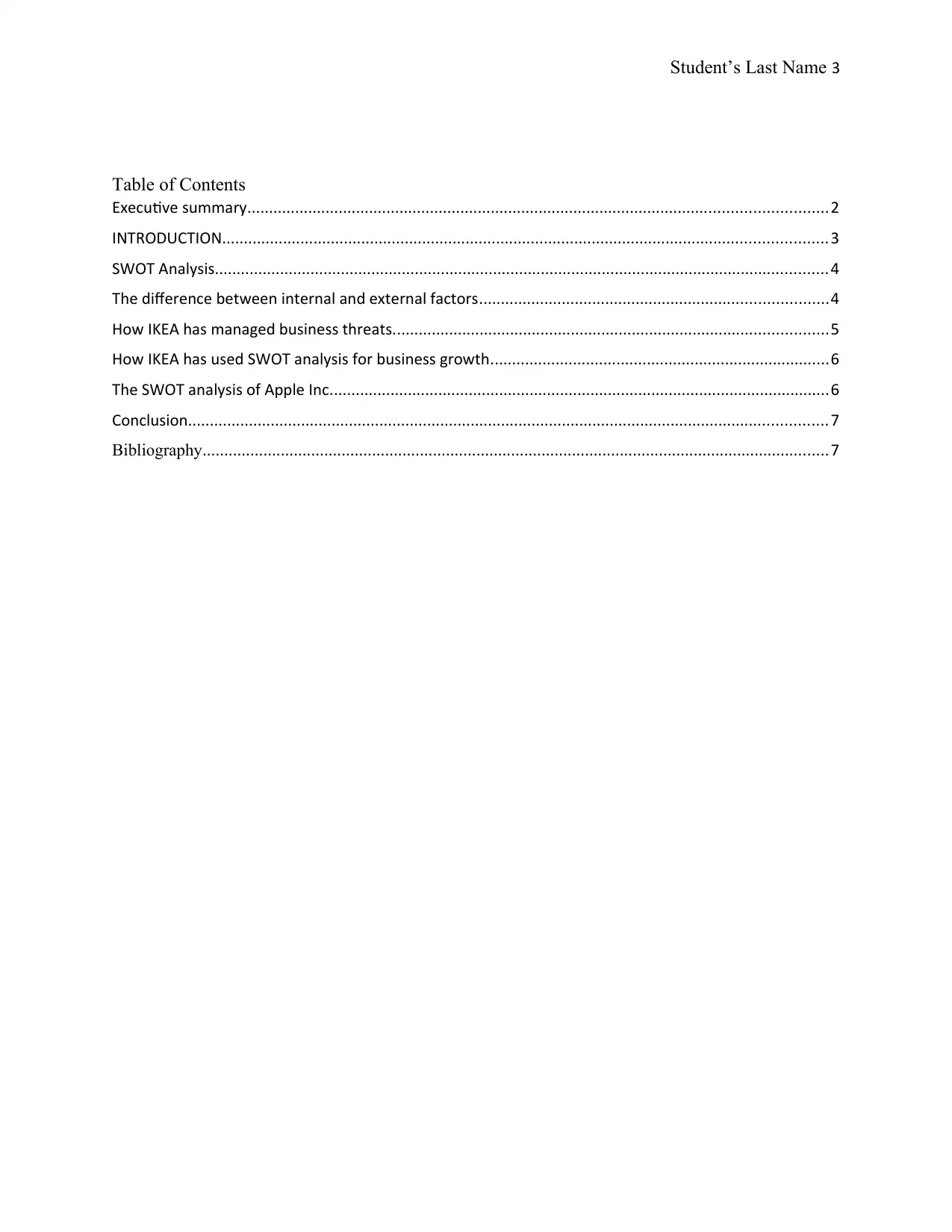
Student’s Last Name 3
Table of Contents
Executive summary.....................................................................................................................................2
INTRODUCTION...........................................................................................................................................3
SWOT Analysis.............................................................................................................................................4
The difference between internal and external factors................................................................................4
How IKEA has managed business threats....................................................................................................5
How IKEA has used SWOT analysis for business growth..............................................................................6
The SWOT analysis of Apple Inc...................................................................................................................6
Conclusion...................................................................................................................................................7
Bibliography................................................................................................................................................7
Table of Contents
Executive summary.....................................................................................................................................2
INTRODUCTION...........................................................................................................................................3
SWOT Analysis.............................................................................................................................................4
The difference between internal and external factors................................................................................4
How IKEA has managed business threats....................................................................................................5
How IKEA has used SWOT analysis for business growth..............................................................................6
The SWOT analysis of Apple Inc...................................................................................................................6
Conclusion...................................................................................................................................................7
Bibliography................................................................................................................................................7
⊘ This is a preview!⊘
Do you want full access?
Subscribe today to unlock all pages.

Trusted by 1+ million students worldwide

Student’s Last Name 4
INTRODUCTION
Marketing strategy is a long-term plan that is developed by business in order to achieve
an effective competitive advantage. It involves positioning the organization strategically in a
competitive environment. These strategies aim to achieve consumer attraction and result in a
higher profit margin. This report will focus on frameworks that can be used to develop an
effective plan. The SWOT analysis is an effective tool that evaluates factors that may internally
or externally affect the business operations. The report will study how IKEA, has employed
SWOT analysis in its marketing strategy.
SWOT Analysis
The SWOT analysis is a strategic planning framework that was developed to analyze and
identify both the internal and external factors that may affect a person, project or an organization.
This analytical framework has four elements which include strength, weakness, opportunities,
and threats (Bull, et al., 2016, pp.100). Strength involve all internal attributes that put the
business at an advantage. Weaknesses are those internal attributes that work against the success
of the business. Opportunities, on the other hand, are external attributes that can give the
business an advantage (Morrison, Pitt, and Kietzmann, 2015, pp.280). This includes factors such
as the involvement of the business in social responsibility. Lastly, threats are external factors that
may have a negative impact on the success of the business. To better understand these elements,
decision makers use the SWOT matrix which organizes all the four elements into 4 quadrants. In
order to carry out an effective SWOT analysis, one has to first formulate an objective for the
business (Brooks, Heffner, and Henderson, 2014, PP.23). The SWOT analysis is an important
framework in assisting a business entity to gain an insight into the current and future position in
relation to the business objectives or the market the business wants to tap in.
INTRODUCTION
Marketing strategy is a long-term plan that is developed by business in order to achieve
an effective competitive advantage. It involves positioning the organization strategically in a
competitive environment. These strategies aim to achieve consumer attraction and result in a
higher profit margin. This report will focus on frameworks that can be used to develop an
effective plan. The SWOT analysis is an effective tool that evaluates factors that may internally
or externally affect the business operations. The report will study how IKEA, has employed
SWOT analysis in its marketing strategy.
SWOT Analysis
The SWOT analysis is a strategic planning framework that was developed to analyze and
identify both the internal and external factors that may affect a person, project or an organization.
This analytical framework has four elements which include strength, weakness, opportunities,
and threats (Bull, et al., 2016, pp.100). Strength involve all internal attributes that put the
business at an advantage. Weaknesses are those internal attributes that work against the success
of the business. Opportunities, on the other hand, are external attributes that can give the
business an advantage (Morrison, Pitt, and Kietzmann, 2015, pp.280). This includes factors such
as the involvement of the business in social responsibility. Lastly, threats are external factors that
may have a negative impact on the success of the business. To better understand these elements,
decision makers use the SWOT matrix which organizes all the four elements into 4 quadrants. In
order to carry out an effective SWOT analysis, one has to first formulate an objective for the
business (Brooks, Heffner, and Henderson, 2014, PP.23). The SWOT analysis is an important
framework in assisting a business entity to gain an insight into the current and future position in
relation to the business objectives or the market the business wants to tap in.
Paraphrase This Document
Need a fresh take? Get an instant paraphrase of this document with our AI Paraphraser

Student’s Last Name 5
The difference between internal and external factors
Internal factors are those within the organization, and business decision makers have a
significant authority over these factors (Antonelli, Crespi, and Scellato, 2013, pp.270). They
include the structure of the organization, human resource, the business culture, leadership styles
and any other factor that is under the control of the management. The strength and weakness are
also classified as internal factors since they exist within the organization. On the other hand,
external factors are those beyond the control of the management. These are factors that exist
outside the control of the management of the business. They are environmental factors that
include the economy, market, politic, and technology (Farahani, et al., 2014, pp.100). Also,
customers and laws governing the operations of the business are also considered under the
external factors. Under the SWOT analysis, external factors are the opportunities and threats.
This is because the business does not have direct influence over them. Although the external
factor exists outside the setting of the business, they can have a significant impact on the
operations of the business.
How IKEA has managed business threats.
The threats that face IKEA are social trends whereby new buyers are unsure of buying
from the housing market, competition from other furnishing companies and recession in the
economy. IKEA has consequently developed a good strategy to counter these threats that affect
their operations. The company utilizes their strengths and opportunities to create a positive
outcome from the threats. In the social trend threat, IKEA addressed the issue by advocating on
how their products are sustainable. IKEA has further developed a mechanism for educating its
customers on sustainability. To counter the emerging competition from other firms, IKEA relies
on their economies of scale to ensure the product cost is lowered for the consumer. Since the
company is large, the production cost per product is low hence the company can lower the price
The difference between internal and external factors
Internal factors are those within the organization, and business decision makers have a
significant authority over these factors (Antonelli, Crespi, and Scellato, 2013, pp.270). They
include the structure of the organization, human resource, the business culture, leadership styles
and any other factor that is under the control of the management. The strength and weakness are
also classified as internal factors since they exist within the organization. On the other hand,
external factors are those beyond the control of the management. These are factors that exist
outside the control of the management of the business. They are environmental factors that
include the economy, market, politic, and technology (Farahani, et al., 2014, pp.100). Also,
customers and laws governing the operations of the business are also considered under the
external factors. Under the SWOT analysis, external factors are the opportunities and threats.
This is because the business does not have direct influence over them. Although the external
factor exists outside the setting of the business, they can have a significant impact on the
operations of the business.
How IKEA has managed business threats.
The threats that face IKEA are social trends whereby new buyers are unsure of buying
from the housing market, competition from other furnishing companies and recession in the
economy. IKEA has consequently developed a good strategy to counter these threats that affect
their operations. The company utilizes their strengths and opportunities to create a positive
outcome from the threats. In the social trend threat, IKEA addressed the issue by advocating on
how their products are sustainable. IKEA has further developed a mechanism for educating its
customers on sustainability. To counter the emerging competition from other firms, IKEA relies
on their economies of scale to ensure the product cost is lowered for the consumer. Since the
company is large, the production cost per product is low hence the company can lower the price

Student’s Last Name 6
of their goods and still remain profitable. Lastly, IKEA addresses economic recession by
lowering the prices of their product. The company, therefore, maintains its position in the market
by attracting consumers with limited financial budgets while still maintaining high-quality
products.
How IKEA has used SWOT analysis for business growth
IKEA has been able to utilize their strength and opportunities to further the business
growth. The company has applied the principle of strength in the following ways. First, IKEA
production process is very sustainable in that the company ensures it does not waste materials in
the production of their products. Also, IKEA recycles waste materials. For example, in the
production of the NORDEN table, the company uses rejected woods from other manufacturers.
The OGLA chair is also made from waste woods from sawmills. The use of recycled materials
saves on the production cost for the company. The company has further taken a huge step in
reclaiming waste product in all its stores. For example between 2007 and 2009, the percentage of
reclaimed product rose from 84 percent to 90 percent. IKEA further source their materials from
nearby supply chains hence reducing their transportation costs. IKEA has utilized its
opportunities in the following ways. The company conserves the environment by reducing its
carbon footprint and water usage and producing sustainable products. This has resulted in the
company tapping into the market of green products. Through its cheap production process, IKEA
offers a low priced product which attracts more consumers.
The SWOT analysis of Apple Inc.
Apple Inc. is headquartered in Cupertino, in the United States. The company deals in
computing technology, cloud computing, consumer electronics and online distribution of digital
contents and services. The SWOT analysis of the company is a presentation of strategic factors
of their goods and still remain profitable. Lastly, IKEA addresses economic recession by
lowering the prices of their product. The company, therefore, maintains its position in the market
by attracting consumers with limited financial budgets while still maintaining high-quality
products.
How IKEA has used SWOT analysis for business growth
IKEA has been able to utilize their strength and opportunities to further the business
growth. The company has applied the principle of strength in the following ways. First, IKEA
production process is very sustainable in that the company ensures it does not waste materials in
the production of their products. Also, IKEA recycles waste materials. For example, in the
production of the NORDEN table, the company uses rejected woods from other manufacturers.
The OGLA chair is also made from waste woods from sawmills. The use of recycled materials
saves on the production cost for the company. The company has further taken a huge step in
reclaiming waste product in all its stores. For example between 2007 and 2009, the percentage of
reclaimed product rose from 84 percent to 90 percent. IKEA further source their materials from
nearby supply chains hence reducing their transportation costs. IKEA has utilized its
opportunities in the following ways. The company conserves the environment by reducing its
carbon footprint and water usage and producing sustainable products. This has resulted in the
company tapping into the market of green products. Through its cheap production process, IKEA
offers a low priced product which attracts more consumers.
The SWOT analysis of Apple Inc.
Apple Inc. is headquartered in Cupertino, in the United States. The company deals in
computing technology, cloud computing, consumer electronics and online distribution of digital
contents and services. The SWOT analysis of the company is a presentation of strategic factors
⊘ This is a preview!⊘
Do you want full access?
Subscribe today to unlock all pages.

Trusted by 1+ million students worldwide
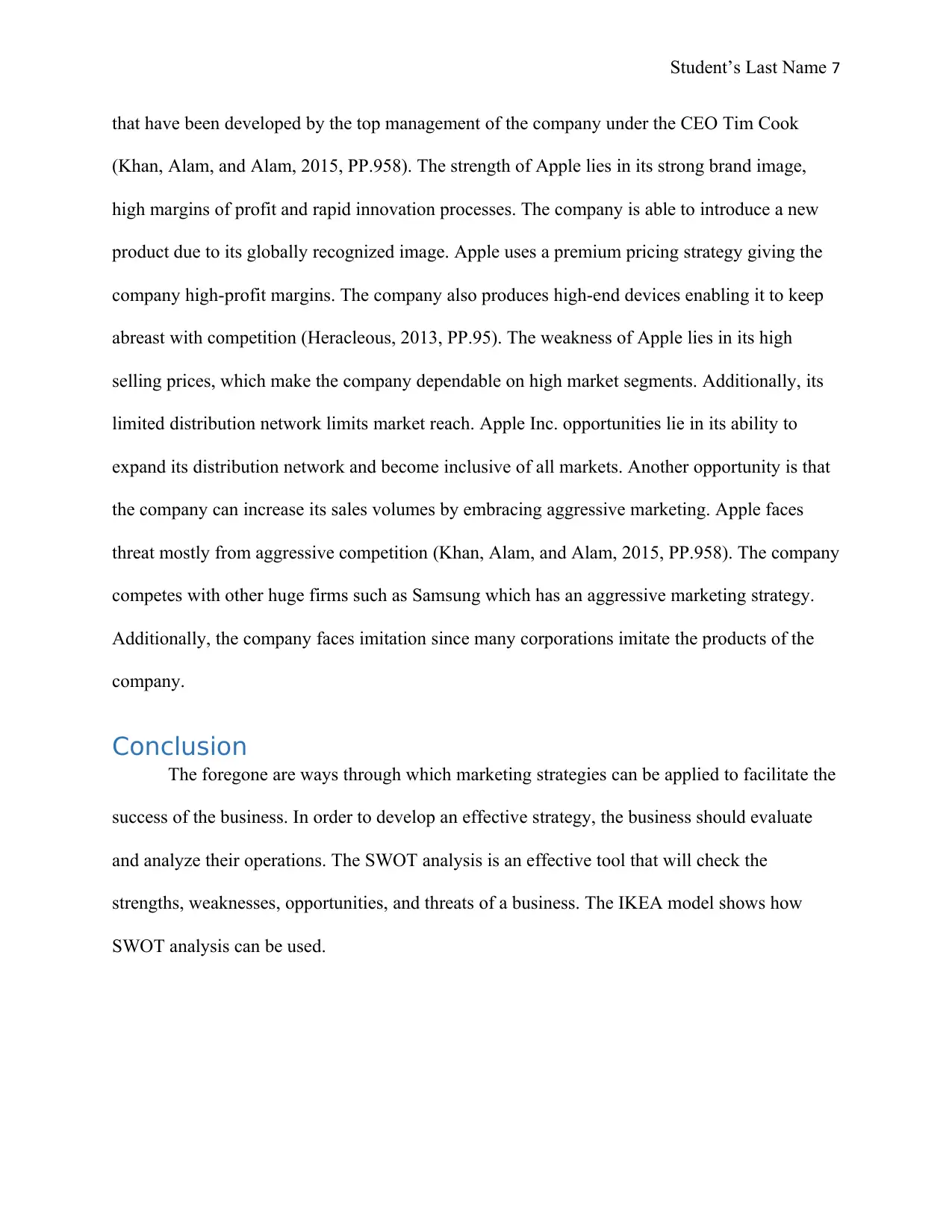
Student’s Last Name 7
that have been developed by the top management of the company under the CEO Tim Cook
(Khan, Alam, and Alam, 2015, PP.958). The strength of Apple lies in its strong brand image,
high margins of profit and rapid innovation processes. The company is able to introduce a new
product due to its globally recognized image. Apple uses a premium pricing strategy giving the
company high-profit margins. The company also produces high-end devices enabling it to keep
abreast with competition (Heracleous, 2013, PP.95). The weakness of Apple lies in its high
selling prices, which make the company dependable on high market segments. Additionally, its
limited distribution network limits market reach. Apple Inc. opportunities lie in its ability to
expand its distribution network and become inclusive of all markets. Another opportunity is that
the company can increase its sales volumes by embracing aggressive marketing. Apple faces
threat mostly from aggressive competition (Khan, Alam, and Alam, 2015, PP.958). The company
competes with other huge firms such as Samsung which has an aggressive marketing strategy.
Additionally, the company faces imitation since many corporations imitate the products of the
company.
Conclusion
The foregone are ways through which marketing strategies can be applied to facilitate the
success of the business. In order to develop an effective strategy, the business should evaluate
and analyze their operations. The SWOT analysis is an effective tool that will check the
strengths, weaknesses, opportunities, and threats of a business. The IKEA model shows how
SWOT analysis can be used.
that have been developed by the top management of the company under the CEO Tim Cook
(Khan, Alam, and Alam, 2015, PP.958). The strength of Apple lies in its strong brand image,
high margins of profit and rapid innovation processes. The company is able to introduce a new
product due to its globally recognized image. Apple uses a premium pricing strategy giving the
company high-profit margins. The company also produces high-end devices enabling it to keep
abreast with competition (Heracleous, 2013, PP.95). The weakness of Apple lies in its high
selling prices, which make the company dependable on high market segments. Additionally, its
limited distribution network limits market reach. Apple Inc. opportunities lie in its ability to
expand its distribution network and become inclusive of all markets. Another opportunity is that
the company can increase its sales volumes by embracing aggressive marketing. Apple faces
threat mostly from aggressive competition (Khan, Alam, and Alam, 2015, PP.958). The company
competes with other huge firms such as Samsung which has an aggressive marketing strategy.
Additionally, the company faces imitation since many corporations imitate the products of the
company.
Conclusion
The foregone are ways through which marketing strategies can be applied to facilitate the
success of the business. In order to develop an effective strategy, the business should evaluate
and analyze their operations. The SWOT analysis is an effective tool that will check the
strengths, weaknesses, opportunities, and threats of a business. The IKEA model shows how
SWOT analysis can be used.
Paraphrase This Document
Need a fresh take? Get an instant paraphrase of this document with our AI Paraphraser
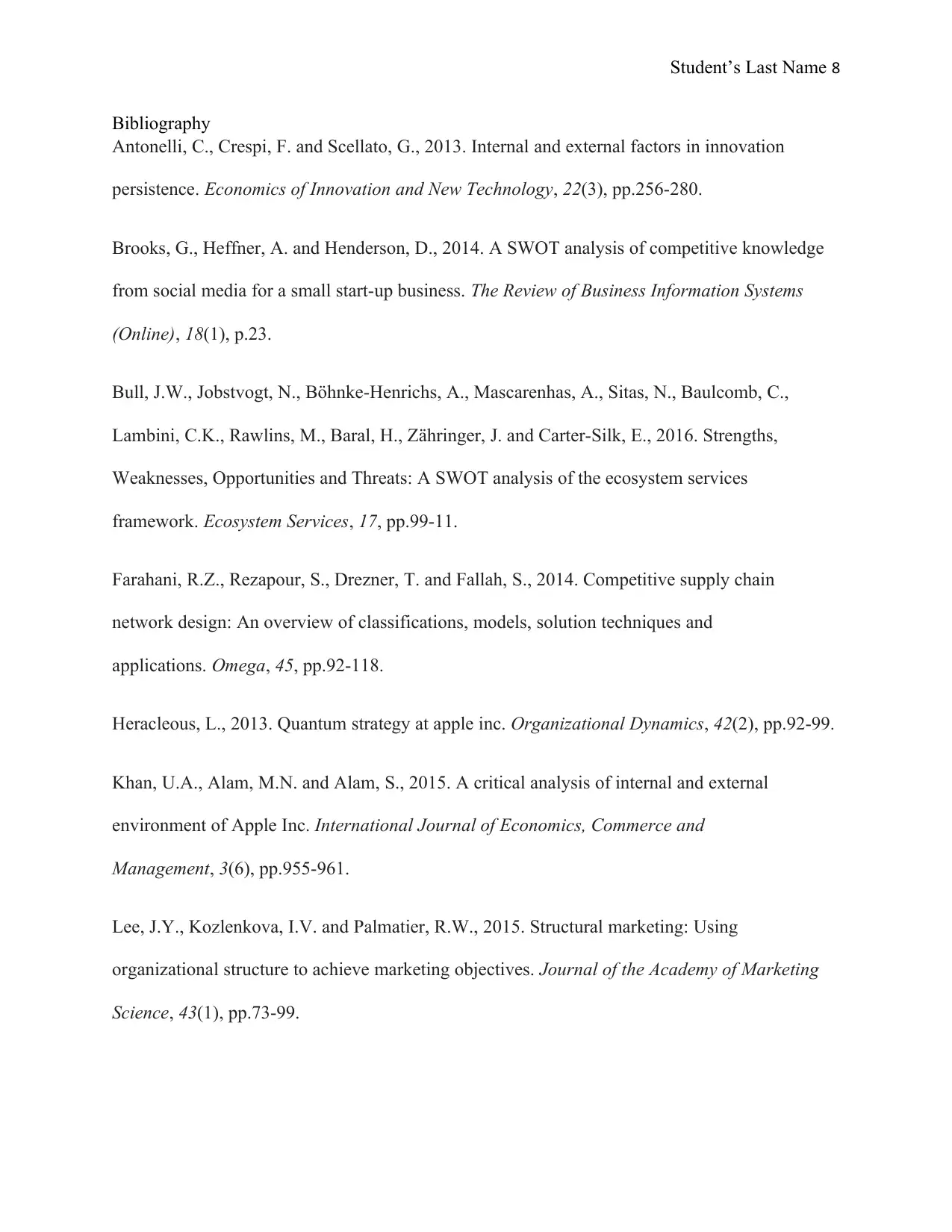
Student’s Last Name 8
Bibliography
Antonelli, C., Crespi, F. and Scellato, G., 2013. Internal and external factors in innovation
persistence. Economics of Innovation and New Technology, 22(3), pp.256-280.
Brooks, G., Heffner, A. and Henderson, D., 2014. A SWOT analysis of competitive knowledge
from social media for a small start-up business. The Review of Business Information Systems
(Online), 18(1), p.23.
Bull, J.W., Jobstvogt, N., Böhnke-Henrichs, A., Mascarenhas, A., Sitas, N., Baulcomb, C.,
Lambini, C.K., Rawlins, M., Baral, H., Zähringer, J. and Carter-Silk, E., 2016. Strengths,
Weaknesses, Opportunities and Threats: A SWOT analysis of the ecosystem services
framework. Ecosystem Services, 17, pp.99-11.
Farahani, R.Z., Rezapour, S., Drezner, T. and Fallah, S., 2014. Competitive supply chain
network design: An overview of classifications, models, solution techniques and
applications. Omega, 45, pp.92-118.
Heracleous, L., 2013. Quantum strategy at apple inc. Organizational Dynamics, 42(2), pp.92-99.
Khan, U.A., Alam, M.N. and Alam, S., 2015. A critical analysis of internal and external
environment of Apple Inc. International Journal of Economics, Commerce and
Management, 3(6), pp.955-961.
Lee, J.Y., Kozlenkova, I.V. and Palmatier, R.W., 2015. Structural marketing: Using
organizational structure to achieve marketing objectives. Journal of the Academy of Marketing
Science, 43(1), pp.73-99.
Bibliography
Antonelli, C., Crespi, F. and Scellato, G., 2013. Internal and external factors in innovation
persistence. Economics of Innovation and New Technology, 22(3), pp.256-280.
Brooks, G., Heffner, A. and Henderson, D., 2014. A SWOT analysis of competitive knowledge
from social media for a small start-up business. The Review of Business Information Systems
(Online), 18(1), p.23.
Bull, J.W., Jobstvogt, N., Böhnke-Henrichs, A., Mascarenhas, A., Sitas, N., Baulcomb, C.,
Lambini, C.K., Rawlins, M., Baral, H., Zähringer, J. and Carter-Silk, E., 2016. Strengths,
Weaknesses, Opportunities and Threats: A SWOT analysis of the ecosystem services
framework. Ecosystem Services, 17, pp.99-11.
Farahani, R.Z., Rezapour, S., Drezner, T. and Fallah, S., 2014. Competitive supply chain
network design: An overview of classifications, models, solution techniques and
applications. Omega, 45, pp.92-118.
Heracleous, L., 2013. Quantum strategy at apple inc. Organizational Dynamics, 42(2), pp.92-99.
Khan, U.A., Alam, M.N. and Alam, S., 2015. A critical analysis of internal and external
environment of Apple Inc. International Journal of Economics, Commerce and
Management, 3(6), pp.955-961.
Lee, J.Y., Kozlenkova, I.V. and Palmatier, R.W., 2015. Structural marketing: Using
organizational structure to achieve marketing objectives. Journal of the Academy of Marketing
Science, 43(1), pp.73-99.

Student’s Last Name 9
Morrison, S., Pitt, L. and Kietzmann, J., 2015. Technology and financial services: Marketing in
times of U-commerce. Journal of Financial Services Marketing, 20(4), pp.273-285.
Morrison, S., Pitt, L. and Kietzmann, J., 2015. Technology and financial services: Marketing in
times of U-commerce. Journal of Financial Services Marketing, 20(4), pp.273-285.
⊘ This is a preview!⊘
Do you want full access?
Subscribe today to unlock all pages.

Trusted by 1+ million students worldwide
1 out of 9
Related Documents
Your All-in-One AI-Powered Toolkit for Academic Success.
+13062052269
info@desklib.com
Available 24*7 on WhatsApp / Email
![[object Object]](/_next/static/media/star-bottom.7253800d.svg)
Unlock your academic potential
Copyright © 2020–2025 A2Z Services. All Rights Reserved. Developed and managed by ZUCOL.





